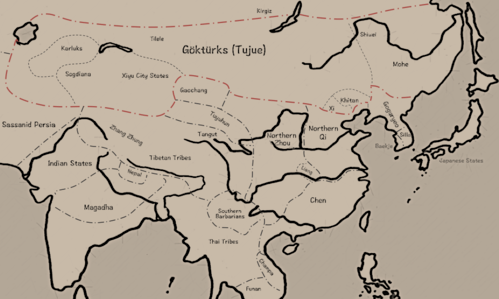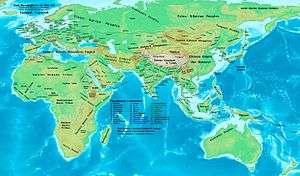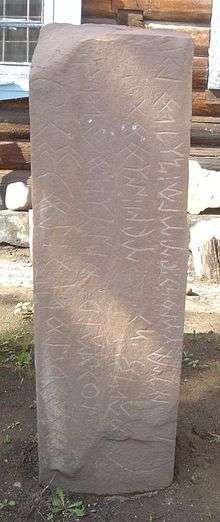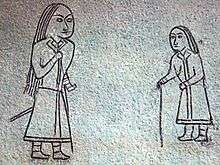Turkic Khaganate
| Turkic Khaganate (Kök) Türük Kaganlıkı Göktürk Kağanlığı | |||||||||||||||||
|---|---|---|---|---|---|---|---|---|---|---|---|---|---|---|---|---|---|
|
552–659 682–744 | |||||||||||||||||
|
The Göktürk Khaganate at its greatest extent, in 576 | |||||||||||||||||
 | |||||||||||||||||
| Status | Khaganate | ||||||||||||||||
| Capital | Ötüken | ||||||||||||||||
| Common languages |
Sogdian(official)[1] Old Turkic | ||||||||||||||||
| Religion | Tengrism, Shamanism, Buddhism | ||||||||||||||||
| Qaghan | |||||||||||||||||
• 551–552 | Bumin Khagan | ||||||||||||||||
• 553–572 | Muqan Qaghan | ||||||||||||||||
• 682–691 | Ilterish Qaghan | ||||||||||||||||
• 742–744 | Ozmış Khagan | ||||||||||||||||
| Legislature | Kurultai (Qurultay) | ||||||||||||||||
| Historical era | Post-classical | ||||||||||||||||
| 542 | |||||||||||||||||
• Established | 552 | ||||||||||||||||
| c. 582 | |||||||||||||||||
• Defeat of Eastern Turkic Khaganate | 630 | ||||||||||||||||
• Defeat of Western Turkic Khaganate | 659 | ||||||||||||||||
• Ilterish Qaghan establishes Second Turkic Khaganate | 682 | ||||||||||||||||
| 744 | |||||||||||||||||
| Area | |||||||||||||||||
| 557[2][3] | 6,000,000 km2 (2,300,000 sq mi) | ||||||||||||||||
| |||||||||||||||||
The Turkic Khaganate (Old Turkic: 𐰜𐰇𐰛:𐱅𐰇𐰼𐰰 Kök Türük; Chinese: 突厥汗国; pinyin: Tūjué hánguó) or Göktürk Khaganate was a khaganate established by the Ashina clan of the Göktürks in medieval Inner Asia. Under the leadership of Bumin Qaghan (d. 552) and his sons, the Ashina succeeded the Rouran Khaganate as the hegemonic power of the Mongolian Plateau and rapidly expanded their territories in Central Asia. Initially the Khaganate would use Sogdian in official and numismatic functions.[1][4] It was the first Turkic state to use the name Türk politically and is known for the first written record of any Turkic language in history.[5]
The first Turkic Khaganate collapsed in 581, after which followed a series of conflicts and civil wars which separated the polity into the Eastern Turkic Khaganate and Western Turkic Khaganate. The Eastern Turkic Khaganate was subjugated by the Tang dynasty in 630 and the Western Turkic Khaganate disintegrated around the same time. The Second Turkic Khaganate emerged in 682 and lasted until 744 when it was overthrown by the Uyghurs, a different Turkic group.
First Khaganate
The origins of the Turkic Khanate trace back to 546, when Bumin Qaghan made a preemptive strike against the Uyghur and Tiele groups planning a revolt against their overlords, the Rouran Khanate. For this service he expected to be rewarded with a Rouran princess, thus marrying into the royal family. However, the Rouran khagan, Yujiulü Anagui, sent an emissary to Bumin to rebuke him, saying, "You are my blacksmith slave. How dare you utter these words?" As Anagui's "blacksmith slave" (Chinese: 鍛奴; pinyin: duànnú) comment was recorded in Chinese chronicles, some claim that the Göktürks were indeed blacksmith servants for the Rouran elite,[6][7][8][9] and that "blacksmith slavery" may have indicated a form of vassalage within Rouran society.[10] According to Denis Sinor, this reference indicates that the Türks specialized in metallurgy, although it is unclear if they were miners or, indeed, blacksmiths.[11][12] Whatever the case, that the Turks were "slaves" need not be taken literally, but probably represented a form of vassalage, or even unequal alliance.[13]
A disappointed Bumin allied with the Western Wei against the Rouran, their common enemy. In 552, Bumin defeated Anagui and his forces north of Huaihuang (modern Zhangjiakou, Hebei).[14]
Having excelled both in battle and diplomacy, Bumin declared himself Illig Khagan of the new khanate at Otukan, but died a year later. His son, Muqan Qaghan, defeated the Hephthalite Empire,[15] Khitan and Kyrgyz.[16] Bumin's brother Istämi (d. 576) bore the title "Yabgu of the West" and collaborated with the Sassanid Empire of Iran to defeat and destroy the Hephthalites, who were allies of the Rouran. This war tightened the Ashina clan's grip on the Silk Road.
The appearance of the Pannonian Avars in the West has been interpreted as a nomadic faction fleeing the westward expansion of the Göktürks, although the specifics are a matter of irreconcilable debate given the lack of clear sources and chronology. Rene Grousset links the Avars with the downfall of the Hephthalites rather than the Rouran,[17] while Denis Sinor argues that Rouran-Avar identification is "repeated from article to article, from book to book with no shred of evidence to support it".[18]
Istämi's policy of western expansion brought the Göktürks into Europe.[19] In 576 the Göktürks crossed the Kerch Strait into the Crimea. Five years later they laid siege to Chersonesus; their cavalry kept roaming the steppes of Crimea until 590.[20] As for the southern borders, they were drawn south of the Amu Darya, bringing the Ashina into conflict with their former allies, the Sasanian Empire. Much of Bactria (including Balkh) remained a dependency of the Ashina until the end of the century.[20]
Civil war

The Turkic Khanate split in two after the death of the fourth ruler, Taspar Qaghan c. 584. He had willed the title of khagan to Muqan's son Apa Qaghan, but the high council appointed Ishbara Qaghan instead. Factions formed around both leaders. Before long, four rivals claimed the title. They were successfully played off against each other by Sui and Tang China.
The most serious contender was the western one, Istämi's son Tardu, a violent and ambitious man who had already declared himself independent from the Qaghan after his father's death. He now seized the title and led an army east to claim the seat of imperial power, Otukan.
In order to buttress his position, Ishbara of the Eastern Khaganate applied to Emperor Yang of Sui for protection. Tardu attacked Chang'an, the Sui capital, around 600, demanding Emperor Yangdi end his interference in the civil war. In retaliation, Chinese diplomacy successfully incited a revolt of Tardu's Tiele vassals, which led to the end of Tardu's reign in 603. Among the dissident tribes were the Uyghurs and Xueyantuo.
Eastern Turkic Khaganate

The civil war left the empire divided into eastern and western parts. The eastern part, still ruled from Otukan, remained in the orbit of the Sui and retained the name Göktürk. The Shibi Khan (609–19) and Illig Qaghan (620–30) attacked China at its weakest moment during the transition between the Sui and Tang. Shibi Khan's surprise attack against Yanmen Commandery during an imperial tour of the northern frontier almost captured Emperor Yang, but his Chinese wife Princess Yicheng—who had been well treated by Empress Xiao during an earlier visit—sent a warning ahead, allowing the emperor and empress time to flee to the commandery seat at present-day Daixian in Shanxi.[21] This was besieged by the Turkish army on September 11, 615,[22][23] but Chinese reinforcements and a false report from Princess Yicheng to her husband about a northern attack on the khaganate caused him to lift the siege before its completion.[21]
In 626, Illig Qaghan took advantage of the Xuanwu Gate Incident and drove on to Chang'an. On September 23, 626[24] Illig Qaghan and his iron cavalry reached the bank of the Wei River north of Bian Bridge (in present-day Xianyang, Shaanxi). On September 25, 626[25] Li Shimin (later Emperor Taizong of Tang) and Illig Qaghan formed an alliance by sacrificing a white horse on Bian Bridge. The Tang paid compensation and promised further tribute, so Illig Qaghan ordered his iron cavalry to withdraw. This is known as the Alliance of the Wei River (渭水之盟), or the Alliance of Bian Qiao (便橋會盟 / 便桥会盟).[26] All in all, 67 incursions on Chinese territories were recorded.[20]
Before mid-October 627, heavy snows on the Mongolian-Manchurian grassland covered the ground to a depth of several feet, preventing the nomads' livestock from grazing and causing a massive die-off among the animals.[27] According to the New Book of Tang, in 628, Taizong mentioned that "There has been a frost in midsummer. The sun had risen from same place for five days. The moon had had the same light level for three days. The field was filled with red atmosphere (dust storm)."[28]
Illig Qaghan was brought down by a revolt of his Tiele vassal tribes (626–630), allied with Emperor Taizong of Tang. This tribal alliance figures in Chinese records as the Huihe (Uyghur).[29]
On March 27, 630[30] a Tang army under the command of Li Jing defeated the Eastern Turkic Khaganate under the command of Illig Qaghan at the Battle of Yinshan (陰山之戰 / 阴山之战).[31][32][33] Illig Qaghan fled to Ishbara Shad, but on May 2, 630[34] Zhang Baoxiang's army advanced to Ishbara Shad's headquarters. Illig Qaghan was taken prisoner and sent to Chang'an.[33] The Eastern Turkic Khaganate collapsed and was incorporated into the Jimi system of Tang. Emperor Taizong said, "It's enough for me to compensate my dishonor at Wei River."[32]
Western Turkic Khaganate
The Western kaghan Sheguy and Tong Yabghu Qaghan constructed an alliance with the Byzantine Empire against the Sasanian Empire and succeeded in restoring the southern borders along the Tarim and Amu Darya rivers. Their capital was Suyab in the Chu River valley, about 6 km south east of modern Tokmok. In 627 Tung Yabghu, assisted by the Khazars and Emperor Heraclius, launched a massive invasion of Transcaucasia which culminated in the taking of Derbent and Tbilisi (see the Third Perso-Turkic War for details). In April 630 Tung's deputy Böri Shad sent the Göktürk cavalry to invade Armenia, where his general Chorpan Tarkhan succeeded in routing a large Persian force. Tung Yabghu's murder in 630 forced the Göktürks to evacuate Transcaucasia.
The Western Turkic Khaganate was modernized through an administrative reform of Ashina Clan (reigned 634–639) and came to be known as the Onoq.[35] The name refers to the "ten arrows" that were granted by the khagan to five leaders (shads) of its two constituent tribal confederations, Dulo and Nushibi, whose lands were divided by the Chui River.[35] The division fostered the growth of separatist tendencies, and soon the Old Great Bulgaria under the Dulo chieftain Kubrat seceded from the khaganate. Tang campaigns against the Western Turks, against the khaganate and their vassals, the oasis states of the Tarim Basin. The Tang campaign against Karakhoja in 640 led to the retreat of the Western Turks, who were defeated during the Tang campaigns against Karasahr in 644 and the Tang campaign against Kucha in 648, [36][37] leading to the In 657 conquest of the Western Turks by the Tang general Su Dingfang.[38]
Emperor Taizong of Tang was proclaimed Khagan of the Göktürks.
In 657, the emperor of China could impose indirect rule in the entire Silk Road as far as Iran. They installed 2 khagans to rule the ten arrows (tribes) of Göktürks. Five arrows of Tulu (咄陆) were ruled by khagan bearing title of Xingxiwang (興昔亡可汗) while five arrows of Nushipi (弩失畢可汗) ruled by Jiwangjue (繼往絕可汗). Five Tulu corresponded to area east of Lake Balkash while five arrows of Nushipi corresponded to the land east of Aral Sea. Göktürks now carried Chinese titles and fought by their side in their wars. The era spanning from 657–699 in the steppes was characterized by numerous rulers – weak, divided, and engaged in constant petty wars under Anxi Protectorate until the rise of Turgesh.
Second Turkic Khaganate
Ilterish Qaghan and his brother Qapaghan Qaghan revolted against the Tang dynasty in 679 and established the Second Turkic Khaganate in 682.[39] Over the following decades they steadily gained control of the steppes beyond the Great Wall of China. By 705, they had expanded as far south as Samarkand and threatened Arab control of Transoxiana. The Göktürks clashed with the Umayyad Caliphate in a series of battles (712–713) but the Arabs emerged as victors.
The Second Khaganate[40][41][42] was centered on Ötüken in the upper reaches of the Orkhon River. This polity was described by historians as "the joint enterprise of the Ashina clan and the Soghdians, with large numbers of Chinese bureaucrats being involved as well".[43] The son of Ilterish, Bilge Qaghan, was also a strong leader whose deeds were recorded in the Orkhon inscriptions. After his death in 734 the Second Turkic Khaganate went into decline. The Göktürks ultimately fell victim to a series of internal crises and renewed Chinese campaigns.
When Kutlug I Bilge Kagan of the Uyghurs allied himself with the Karluks and Basmyls, the power of the Göktürks was very much on the wane. In 744 Kutlug seized Ötüken and beheaded the last Göktürk khagan, Ozmish Qaghan, whose head was sent to the Tang court.[44] In the span of a few years, the Uyghurs gained mastery of Inner Asia and established the Uyghur Khaganate.
Customs and culture
Political system
The Göktürks were governed by Kurultai, a political and military council of khans and other high ranking leaders, such as aqsaqals.[45]
The Turkic temporary qaghan from the Ashina clan were subordinate to a sovereign authority, the kurultai.
Religion
The Göktürks and other ancient Turkic peoples were mainly adherents of Tengrism, worshipping the sky god Tengri. The Khaganate received missionaries from the Buddhist religion, which was incorporated into Tengrism. After the fall of the khaganate, many refugees settled in Central Asia, the Middle East and Europe, and adopted the Islamic faith.
See also
External links
References
- 1 2 Roux 2000, p. 79.
- ↑ Turchin, Peter; Adams, Jonathan M.; Hall, Thomas D (December 2006). "East-West Orientation of Historical Empires". Journal of world-systems research. 12 (2): 222. ISSN 1076-156X. Retrieved 16 September 2016.
- ↑ Taagepera, Rein (1979). "Size and Duration of Empires: Growth-Decline Curves, 600 B.C. to 600 A.D". Social Science History. 3 (3/4): 129. doi:10.2307/1170959. JSTOR 1170959.
- ↑ Baratova 2005.
- ↑ West, Barbara A. (2010-05-19). Encyclopedia of the Peoples of Asia and Oceania. Infobase Publishing. p. 829. ISBN 978-1-4381-1913-7.
The first people to use the ethnonym Turk to refer to themselves were the Turuk people of the Gokturk Khanate in the mid sixth-century
- ↑ 馬長壽, 《突厥人和突厥汗國》, 上海人民出版社, 1957,p. 10-11 (in Chinese)
- ↑ 陳豐祥, 余英時, 《中國通史》, 五南圖書出版股份有限公司, 2002, ISBN 978-957-11-2881-8, p. 155 (in Chinese)
- ↑ Gao Yang, "The Origin of the Turks and the Turkish Khanate", X. Türk Tarih Kongresi: Ankara 22 – 26 Eylül 1986, Kongreye Sunulan Bildiriler, V. Cilt, Türk Tarih Kurumu, 1991, s. 731. (in English)
- ↑ Burhan Oğuz, Türkiye halkının kültür kökenleri: Giriş, beslenme teknikleri, İstanbul Matbaası, 1976, p. 147. «Demirci köle» olmaktan kurtulup reisleri Bumin'e (in Turkish)
- ↑ Larry W. Moses, "Relations with the Inner Asian Barbarian", ed. John Curtis Perry, Bardwell L. Smith, Essays on Tʻang society: the interplay of social, political and economic forces, Brill Archive, 1976, ISBN 978-90-04-04761-7, p. 65. '"Slave" probably meant vassalage to the Juan Juan [=Ruanruan or Rouran] qaghan, whom they [the Türks] served in battle by providing iron weapons, and also marching with the qaghan's armies.' (in English)
- ↑ Denis Sinor, Inner Asia: history-civilization-languages : a syllabus, Routledge, 1997, ISBN 978-0-7007-0380-7, p. 26. Contacts had already begun in 545 A.D. between the so-called "blacksmith-slave" Türk and certain of the kingdoms of north China,
- ↑ Denis Sinor, ibid, p. 101. 'Beyond A-na-kui's disdainful reference to his "blacksmith slaves" there is ample evidence to show that the Turks were indeed specializing in metallurgy, though it is difficult to establish whether they were miners or rather blacksmiths.' (in English)
- ↑ Nachaeva (2011)
- ↑ Linghu Defen et al., Book of Zhou, Vol. 50. (in Chinese)
- ↑ Li Yanshou (李延寿), History of Northern Dynasties, Vol. 99.
- ↑ Sima Guang, Zizhi Tongjian, Vol. 166.
- ↑ Grousset (1970, p. 82)
- ↑ History and historiography of the Nomad Empires of Central Eurasia. D Sinor. Acta Orientalia Academiae Scientarum Hung. 58 (1) 3 – 14, 2005
- ↑ Walter Pohl, Die Awaren: ein Steppenvolk im Mitteleuropa, 567–822 n. Chr, C.H.Beck (2002), ISBN 978-3-406-48969-3, p. 26-29.
- 1 2 3 Grousset 81.
- 1 2 Xiong (2006), pp. 63–4.
- ↑ 大業十一年 八月癸酉 Academia Sinica Archived 2010-05-22 at the Wayback Machine. (in Chinese)
- ↑ Sima Guang, Zizhi Tongjian, Vol. 182. (in Chinese)
- ↑ 武德九年 八月癸未 Academia Sinica Archived 2010-05-22 at the Wayback Machine. (in Chinese)
- ↑ 武德九年 八月乙酉 Academia Sinica Archived 2010-05-22 at the Wayback Machine. (in Chinese)
- ↑ Sima Guang, Zizhi Tongjian, Vol. 191. (in Chinese)
- ↑ David Andrew Graff, Medieval Chinese warfare, 300–900, Routledge, 2002, ISBN 978-0-415-23955-4, p. 186.
- ↑ Ouyang Xiu, New Book of Tang, Vol. 215-I (in Chinese)
- ↑ Liu 劉, Xu 昫 (945). Old Book of Tang 舊唐書 Vol.194 & Vol.195.
- ↑ 貞觀四年 二月甲辰 Academia Sinica Archived 2010-05-22 at the Wayback Machine. (in Chinese)
- ↑ Old Book of Tang, Vol. 3. (in Chinese)
- 1 2 Ouyang Xiu et al., New Book of Tang, Vol. 93. (in Chinese)
- 1 2 Sima Guang, Zizhi Tongjian, Vol. 193. (in Chinese)
- ↑ 貞觀四年 三月庚辰
- 1 2 Gumilev 238.
- ↑ Grousset 1970, pp. 99–100.
- ↑ Wechsler 1979, pp. 225–228.
- ↑ Skaff 2009, p. 183.
- ↑ Barfield, Thomas J. The Perilous Frontier: Nomadic Empires and China. Cambridge, Mass.: B. Blackwell, 1989. Print.
- ↑ Elena Vladimirovna Boĭkova, R. B. Rybakov, Kinship in the Altaic World: Proceedings of the 48th Permanent International Altaistic Conference, Moscow 10–15 July 2005, Otto Harrassowitz Verlag, 2006, ISBN 978-3-447-05416-4, p. 225.
- ↑ Anatoly Michailovich Khazanov, Nomads and the Outside World, Univ of Wisconsin Press, 1984, ISBN 978-0-299-14284-1, p. 256.
- ↑ András Róna-Tas, An introduction to Turkology, Universitas Szegediensis de Attila József Nominata, 1991, p. 29.
- ↑ Wink 66.
- ↑ Grousset 114.
- ↑ {{source|last=Balaban|first=Ayhan|title=İskit, Hun ve Göktürklerde Sosyal ve Ekonomik Hayat|publisher=T.C. Gazi Üniversitesi Sosyal Bilimler Enstitüsü|year=2006|url=http://fef.kafkas.edu.tr/sosyb/tde/halk_bilimi/makaleler/kultur_med/kultur_med%20(20).pdf |accessdate=11 December 2011|language=Turkish|Archived by WebCite® at https://www.webcitation.org/63rPeTJL1?url=http://fef.kafkas.edu.tr/sosyb/tde/halk_bilimi/makaleler/kultur_med/kultur_med%20(20).pdf
Bibliography
- Asimov, M.S. (1998), History of civilizations of Central Asia Volume IV The age of achievement: A.D. 750 to the end of the fifteenth century Part One The historical, social and economic setting, UNESCO Publishing
- Baratova, Larissa (2005). "Turko-Sogdian Coinage". Encyclopedia Iranica.
- Barfield, Thomas (1989), The Perilous Frontier: Nomadic Empires and China, Basil Blackwell
- Benson, Linda (1998), China's last Nomads: the history and culture of China's Kazaks, M.E. Sharpe
- Bregel, Yuri (2003), An Historical Atlas of Central Asia, Brill
- Bosworth, Clifford Edmund (2000), The Age of Achievement: A.D. 750 to the End of the Fifteenth Century - Vol. 4, Part II : The Achievements (History of Civilizations of Central Asia), UNESCO Publishing
- Bughra, Imin (1983), The history of East Turkestan, Istanbul: Istanbul publications
- Drompp, Michael Robert (2005), Tang China And The Collapse Of The Uighur Empire: A Documentary History, Brill
- Haywood, John (1998), Historical Atlas of the Medieval World, AD 600-1492, Barnes & Noble
- Latourette, Kenneth Scott (1964), The Chinese, their history and culture, Volumes 1-2, Macmillan
- Mackerras, Colin (1990), "Chapter 12 - The Uighurs", in Sinor, Denis, The Cambridge History of Early Inner Asia, Cambridge University Press, pp. 317–342, ISBN 0 521 24304 1
- Millward, James A. (2007), Eurasian Crossroads: A History of Xinjiang, Columbia University Press
- Mackerras, Colin, The Uighur Empire: According to the T'ang Dynastic Histories, A Study in Sino-Uighur Relations, 744-840. Publisher: Australian National University Press, 1972. 226 pages, ISBN 0-7081-0457-6
- Golden, Peter B. (2011), Central Asia in World History, Oxford University Press
- Roux, Jean-Paul (2000). Histoire des Turcs (in French). Fayard.
- Sinor, Denis (1990), The Cambridge History of Early Inner Asia, Cambridge University Press, ISBN 978-0-521-24304-9
- Xiong, Victor Cunrui (2006), Emperor Yang of the Sui Dynasty: His Life, Times, and Legacy, Albany: State University of New York Press .
- Xiong, Victor (2008), Historical Dictionary of Medieval China, United States of America: Scarecrow Press, Inc., ISBN 0810860538
- Xue, Zongzheng (薛宗正). (1992). Turkic peoples (突厥史). Beijing: 中国社会科学出版社. ISBN 978-7-5004-0432-3; OCLC 28622013

